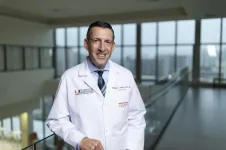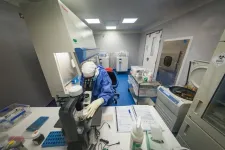(Press-News.org) Peer-reviewed / Observational study / People
The Lancet Oncology: Risk of dying from cancer in some poorer districts of England over 70% higher than wealthy districts, study suggests
Analysis of the risk of dying from the most cancers with the largest death toll across the 314 districts in England finds that in 2019 the highest risks were in northern cities such as Liverpool, Manchester, Hull and Newcastle, and in coastal areas to the east of London.
The risk of dying from cancer before 80 years of age ranged from one in ten in Westminster to one in six in Manchester for women, and from one in eight in Harrow to one in five in Manchester for men.
Nationally, the risk of dying from cancer declined for both men and women from 2002-2019, from one in six to one in eight for women and from one in five to one in six for men.
Risk of dying from a cancer was associated with poverty for both sexes, and the greatest inequality across regions was for cancers with risk factors such as smoking, alcohol and obesity, and for those which could be prevented or detected early by screening programmes.
The probability of dying from each cancer group for each gender in each of the 314 districts is available here: https://imperialcollegelondon.box.com/s/8curcuwugv6zb2jstlcpdlb34hed5iim
The risk of dying from the 10 forms of cancer with the largest death toll [1] for men and women varies massively depending on the district in England where people live, according to a study published in The Lancet Oncology.
Cancer is now the leading cause of death in England, having overtaken cardiovascular diseases, however there is a lack of data on the risk of dying from different types of cancer, and how much this risk has changed over the last 20 years, on a district-level. [2]
This study is the first to estimate how much the risk of dying from cancer in England has changed from 2002 to the onset of the COVID-19 pandemic for areas as small as local authority districts.
“Although our study brings the good news that the overall risk of dying from cancer has decreased across all English districts in the last 20 years, it also highlights the astounding inequality in cancer deaths in different districts around England,” says Prof Majid Ezzati, senior author of the study and Professor of Global Environmental Health, Imperial College London. [3]
The researchers used death records in England from 2002 to 2019 to measure the number of deaths caused by the 10 cancers with the largest death toll for each of men and women in the 314 regions in England. Using a statistical model that could handle small numbers, they estimated the risk of dying before 80 years of age from each of the 10 cancer types for men and women in each district for each year between 2002 to 2019.
The authors also used the proportion of the district population claiming income-related benefits due to being out-of-work or having low earnings to work out the relationship between risk of dying from cancer and poverty in the district.
Changes in risk of dying from cancer from 2002 – 2019
Nationally, the risk of dying from cancer before 80 years of age declined for both sexes from 2002-2019, from one in six to one in eight for women and from one in five to one in six for men.
However, some regions had a larger decline than others. For women, the greatest district-level reduction in the risk of dying from a cancer was nearly five times that of the smallest (30.1% decline in Camden, compared to a 6.6% decline in Tendring). For men, the largest decrease was triple that of the smallest (36.7% in Tower Hamlets compared to 12.8% in Blackpool). Overall, districts in London achieved the largest declines.
The risk of dying did not decrease for all types of cancer as the risk of dying from pancreatic cancer increased for men and women in all districts apart from one, and the risk of dying from liver cancer among men and from endometrial cancer among women increased in all districts.
Although deaths from lung cancer reduced from 2002 to 2019 in every district for men, the result was more mixed for women with the risk of dying decreasing in many districts, particularly in London, but mostly staying the same elsewhere and increasing in some areas in the East of England. The authors speculate that this is due to the rise and fall in female smoking lagging behind men by about 20-30 years.
Inequalities in cancer mortality in 2019
In 2019, the risk of dying from cancer before 80 years of age ranged from one in 10 in Westminster to one in six in Manchester for women, and from one in eight in Harrow to one in five in Manchester for men. The highest risks of dying were in northern cities such as Liverpool, Manchester, Hull and Newcastle, and in coastal areas to the east of London.
The risk of dying from cancer was higher for both men and women in districts with more poverty. In part, this was due to the risk of dying from lung cancer - the leading cancer cause of death for both sexes - being strongly linked with poverty. Lung cancer was also one of the cancers with the most inequality in risk of dying across different districts, with women in Knowlsey in 2019 having triple the risk of dying from lung cancer than those in Waverley, and men in Manchester having triple the risk of dying from lung cancer than men in Guildford.
Both men and women in poor districts of London had lower probabilities of dying from lung, colorectal and oesophageal cancer and men had a lower risk of dying from bladder cancer than in comparably poor districts in the rest of the country. Authors suggest this may be due to a combination of differences in cancer risk factors, such as smoking rates, between London’s ethnically diverse population and the rest of England, and differences in the quality of healthcare, with Londoners more likely to have access to specialised hospitals and advanced treatments such as immunotherapies.
“The greatest inequality across districts was for the risk of dying from cancers where factors such as smoking, alcohol and obesity have a large influence on the risk of getting cancer. Due to funding cuts, many local authorities have reduced their budgets for smoking cessation since 2010. Our data shows we cannot afford to lose these public health programmes and are in urgent need of the reintroduction and strengthening of national and local policies which combat smoking and alcohol,” says Theo Rashid, first author and PhD student at Imperial College London. [3]
“Access to cancer screening and diagnostic services which can prevent cancer or catch it early are key in reducing some of the inequalities our study highlights. Those who are more deprived are less likely to be able to access and engage with cancer screening. To change this, there needs to be investment into new ways to reach under-served groups, such as screening ‘pop-ups’ in local areas like supermarkets and working with community organisations and faith groups,” adds Prof Amanda Cross, study author and Professor of Cancer Epidemiology, Imperial College London. [3]
The authors acknowledge some limitations of the study, including that they only analysed deaths from the 10 cancers with the highest death toll and did not separate the remaining group of cancer deaths into more specific cancer groups. Additionally, the correlations with poverty were reported at the district level, but there are variations in both risk of dying from cancer and levels of poverty within each district. Finally, the authors caution that this data only goes up to 2019 and say there is a need for further research to find out what happened to the risk of dying from cancer during the COVID-19 pandemic and corresponding pressures on the NHS.
Writing in a linked Comment, Dr Karri Seppä and Prof Janne Pitkäniemi, Finnish Cancer Registry, Finland, who were not involved in the study, say, “High-resolution population-based cancer statistics are important to gain a more comprehensive picture of geographical variation in cancer burden. These statistics might identify differences that are important for the prevention of new cancers and the improvements in early detection and cancer survival.”
NOTES TO EDITORS
This study was funded by Wellcome Trust, Imperial College London, UKRI (MRC) and National Institute of Health and Care Research. It was conducted by researchers from Imperial College London.
[1] For men: Lung, Prostate, Colorectal, Oesophageal, Pancreatic, Stomach, Lymphoma and multiple myeloma, Bladder, Leukaemia and Liver. For women: Lung, Breast, Colorectal, Pancreatic, Ovarian, Lymphoma and multiple myeloma, Oesophageal, Leukaemia, Corpus uteri and Stomach.
[2] The districts in England are ways which divide up the country for the purposes of local government and include metropolitan boroughs, London boroughs, non-metropolitan districts and unitary authorities, as well as the City of London and Isles of Scilly. In 2020 when the study analysis was done, England had 314 districts.
[3] Quote direct from author and cannot be found in the text of the Article.
The labels have been added to this press release as part of a project run by the Academy of Medical Sciences seeking to improve the communication of evidence. For more information, please see: http://www.sciencemediacentre.org/wp-content/uploads/2018/01/AMS-press-release-labelling-system-GUIDANCE.pdf if you have any questions or feedback, please contact The Lancet press office pressoffice@lancet.com
END
The Lancet Oncology: Risk of dying from cancer in some poorer districts of England over 70% higher than wealthy districts, study suggests
2023-12-12
ELSE PRESS RELEASES FROM THIS DATE:
14-inch spacecraft delivers new details about ‘hot Jupiters'
2023-12-12
A spacecraft the size of a cereal box has collected precise measurements of the atmospheres of large and puffy planets called “hot Jupiters.” The findings, led by a team from the University of Colorado Boulder, could help reveal how the atmospheres around these and a host of other worlds are escaping into space.
The observations are the first results to come from a hard-working NASA spacecraft known as the Colorado Ultraviolet Transit Experiment (CUTE).
Kevin France, principal investigator for the mission, will present the group’s results at a media availability Monday, Dec. 11 at 4:30 p.m. at the 2023 meeting of the American ...
Patients with a common form of acute myeloid leukemia report better quality of life when treatment includes new drug quizartinib
2023-12-12
DOWNLOADABLE VIDEO
MIAMI, FLORIDA (EMBARGOED UNTIL MONDAY, DEC. 11, 2023 @ 7 P.M. ET) – In a study led by researchers at Sylvester Comprehensive Cancer Center at the University of Miami Miller School of Medicine, patients recently diagnosed with a common and aggressive form of acute myeloid leukemia reported having improved quality of life when a newly approved drug was part of the treatment plan.
Study results will be released during an oral presentation at the 65th ASH Annual Meeting and Exposition, the American Society of Hematology’s conference taking place in San Diego, California, Dec. 9-12. The ...
Roman ‘backwater’ bucked Empire’s decline, archaeologists reveal
2023-12-12
UNDER STRICT EMBARGO UNTIL 00:01 AM (UK TIME) ON TUESDAY 12TH DECEMBER 2023
A rare roofed theatre, markets, warehouses, a river port and other startling discoveries made by a Cambridge-led team of archaeologists challenge major assumptions about the decline of Roman Italy.
New findings from Interamna Lirenas, traditionally written off as a failed backwater in Central Italy, change our understanding of Roman history, its excavators believe.
Their thirteen-year study – published today in the edited volume Roman Urbanism in Italy ...
Genetic “protection” against depression was no match for pandemic stress
2023-12-12
Living through a historic pandemic while handling the stress of the first year of college sent one-third of students in a new study into clinical depression. That’s double the percentage seen in previous years of the same study.
And while certain genetic factors appeared to shield first-year students in pre-pandemic years from depression, even students with these protective factors found themselves developing symptoms in the pandemic years.
In fact, much of the overall rise in student depression during the pandemic was among young women with this kind of “genetic resilience.”
But ...
UC San Diego Health completes acquisition of Alvarado Hospital Medical Center
2023-12-12
On December 11, 2023, UC San Diego Health successfully completed the purchase of Alvarado Hospital Medical Center from Prime Healthcare. The acquisition of the 302-bed medical facility greatly expands the university’s growing network of clinics and hospitals to better serve patients with safe, timely and equitable access to high-quality health care.
“We are grateful to all the teams who contributed to this milestone merger with UC San Diego Health. Together, we start a new chapter to expand access to needed medical and surgical care in eastern ...
Third-generation anti-CD19 CAR T-cells demonstrate efficacy without neurotoxicity in B-cell lymphoma phase 1 clinical trial
2023-12-12
The Malaghan Institute of Medical Research in collaboration with Wellington Zhaotai Therapies Limited today announced results of its phase 1 dose escalation trial of a new third generation anti-CD19 chimeric antigen receptor (CAR) T-cell therapy to be presented at the American Society of Hematology (ASH) Annual Meeting in San Diego on 11 December, 3pm.
Anti-CD19 CAR T-cells with a CD28 co-stimulatory domain, such as axicabtagene ciloleucel and brexucabtagene autoleucel, are among the most effective CAR T-cell therapies for B-cell non-Hodgkin lymphomas but are associated with neurotoxicity (immune effector cell-associated neurotoxicity syndrome, ICANS) in around half of recipients, ...
ASA endorses new legislation to fully avert Medicare payment cuts
2023-12-11
The American Society of Anesthesiologists (ASA) strongly endorses H.R. 6683, legislation that would block a more than 3% Medicare payment cut scheduled to take effect on January 1, 2024. ASA supports the immediate passage of this legislation this year or early 2024, prior to full implementation of these destructive cuts.
“We commend these lawmakers for their leadership on preventing this Medicare payment cut and their efforts to ensure the viability of the nation’s physician practices,” said ASA President Ronald ...
Applications open for School of Advanced Science on Quantum Materials
2023-12-11
Registrations are open to apply for the São Paulo School of Advanced Science on Quantum Materials, to be held on July 6-16, 2024, at the University of São Paulo’s Physics Institute in São Paulo City, Brazil. The School expects to select and fully support 100 graduate students and young researchers (50 from Brazil and 50 from abroad) to take part in short courses and talks focusing on fundamental, theoretical, and experimental aspects of quantum materials – a fertile ...
NASA’s Webb stuns with new high-definition look at exploded star
2023-12-11
Like a shiny, round ornament ready to be placed in the perfect spot on a holiday tree, supernova remnant Cassiopeia A (Cas A) gleams in a new image from NASA’s James Webb Space Telescope. As part of the 2023 Holidays at the White House, First Lady of the United States Dr. Jill Biden debuted the first-ever White House Advent Calendar. To showcase the “Magic, Wonder, and Joy” of the holiday season, Dr. Biden and NASA are celebrating with this new image from Webb.
While all ...
NASA’s MAVEN observes the disappearing solar wind
2023-12-11
In December 2022, NASA’s MAVEN (Mars Atmosphere and Volatile EvolutioN) mission observed the dramatic and unexpected “disappearance” of a stream of charged particles constantly emanating off the Sun, known as the solar wind. This was caused by a special type of solar event that was so powerful, it created a void in its wake as it traveled through the solar system.
Due to this event, MAVEN’s measurements at Mars showed that the number of particles making up the solar wind dropped significantly. Without the pressure of the solar wind, the Martian atmosphere and magnetosphere expanded by thousands of kilometers. MAVEN is the only asset currently at Mars able to ...




